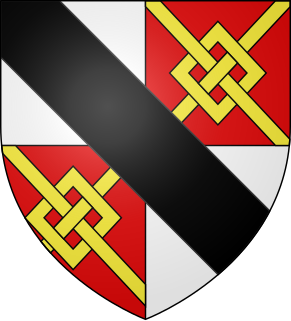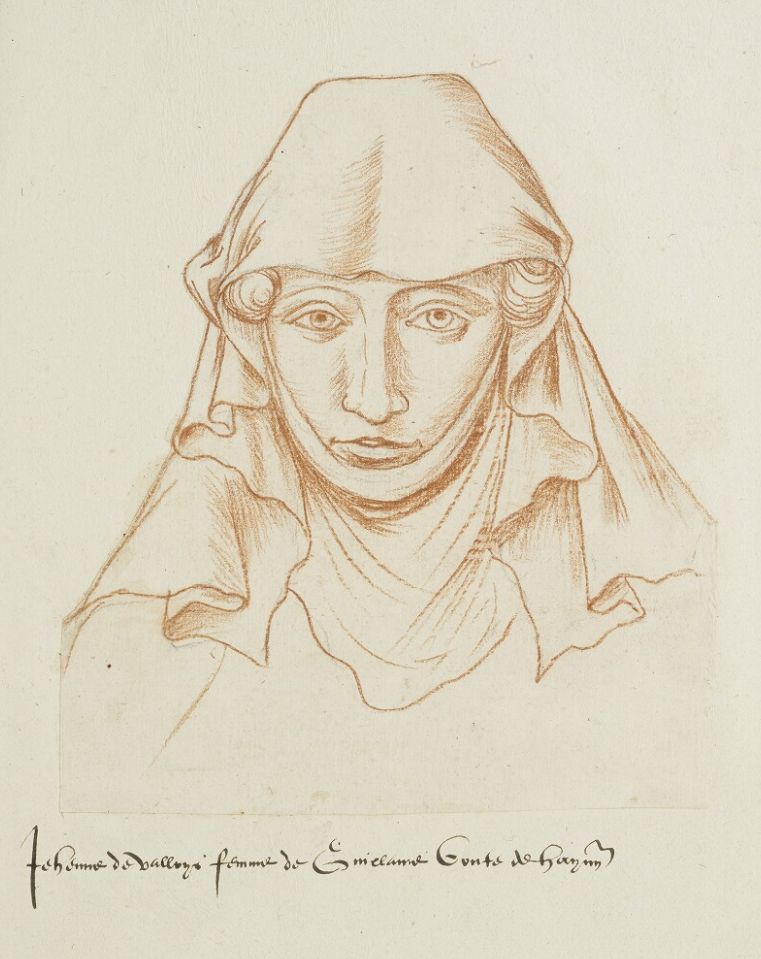
Isabella of France, sometimes described as the She-Wolf of France, was Queen of England as the wife of Edward II, and regent of England from 1327 until 1330. She was the youngest surviving child and only surviving daughter of Philip IV of France and Joan I of Navarre. Isabella was notable in her lifetime for her diplomatic skills, intelligence, and beauty. She became a "femme fatale" figure in plays and literature over the years, usually portrayed as a beautiful but cruel and manipulative figure.
Margaret de Clare, Countess of Gloucester, Countess of Cornwall was an English noblewoman, heiress, and the second-eldest of the three daughters of Gilbert de Clare, 6th Earl of Hertford and his wife Joan of Acre, making her a granddaughter of King Edward I of England. Her two husbands were Piers Gaveston and Hugh de Audley, 1st Earl of Gloucester.

Roger Mortimer, 3rd Baron Mortimer, 1st Earl of March, was an English nobleman and powerful Marcher lord who gained many estates in the Welsh Marches and Ireland following his advantageous marriage to the wealthy heiress Joan de Geneville, 2nd Baroness Geneville. In November 1316, he was appointed Lord Lieutenant of Ireland. He was imprisoned in the Tower of London in 1322 for having led the Marcher lords in a revolt against King Edward II in what became known as the Despenser War. He later escaped to France, where he was joined by Edward's queen consort Isabella, whom he may have taken as his mistress. After he and Isabella led a successful invasion and rebellion, Edward was deposed; Mortimer allegedly arranged his murder at Berkeley Castle. For three years, Mortimer was de facto ruler of England before being himself overthrown by Edward's eldest son, Edward III. Accused of assuming royal power and other crimes, Mortimer was executed by hanging at Tyburn.

Baron le Despencer is a title that has been created several times by writ in the Peerage of England.

Hugh le Despenser, sometimes referred to as "the Elder Despenser," was for a time the chief adviser to King Edward II of England.

Hugh le Despenser, 1st Lord Despenser, also referred to as "the younger Despenser", was the son and heir of Hugh le Despenser, Earl of Winchester by his wife Isabella de Beauchamp, daughter of William de Beauchamp, 9th Earl of Warwick. He rose to national prominence as royal chamberlain and a favourite of Edward II of England. Despenser made many enemies across the nobility of England which, after the overthrow of Edward, eventually led to him being charged with high treason and ultimately hanged, drawn and quartered.

Eleanor de Clare, suo jure 6th Lady of Glamorgan was a powerful English noblewoman who married Hugh Despenser the Younger and was a granddaughter of Edward I of England. With her sisters, Elizabeth de Clare and Margaret de Clare, she inherited her father's estates after the death of her brother, Gilbert de Clare, 8th Earl of Gloucester, 7th Earl of Hereford at the Battle of Bannockburn in 1314. She was born in 1292 at Caerphilly Castle in Glamorgan, Wales and was the eldest daughter of Gilbert de Clare, 6th Earl of Hertford, 7th Earl of Gloucester, 5th Lord of Glamorgan and Princess Joan of Acre.

John de Bohun, 5th Earl of Hereford was born in St Clement's, Oxford to Humphrey de Bohun, 4th Earl of Hereford and Elizabeth of Rhuddlan, a daughter of Edward I of England.

Joan of Valois was a Countess consort of Hainaut, Holland, and Zeeland. She was the second eldest daughter of the French prince Charles, Count of Valois, and his first wife, Margaret, Countess of Anjou. As the sister of King Philip VI of France and the mother-in-law of Edward III, she was ideally placed to act as mediator between them.

Thomas le Despenser, 2nd Baron Despenser, 1st Earl of Gloucester KG was the son of Edward le Despenser, 1st Baron le Despencer, whom he succeeded in 1375.
Spencer is a surname, representing the court title dispenser, or steward. An early example is Robert d'Abbetot, who is listed as Robert le Dispenser, a tenant-in-chief of several counties, in the Domesday Book of 1086. In early times the surname was usually written as le Despenser, Dispenser or Despencer—notably in works such as the Domesday Book and the Scottish Ragman Rolls of 1291 and 1296, but gradually lost both the "le" article and the unstressed first syllable of the longer surname to become Spencer.
Events from the 1320s in England.

Henry le Despenser was an English nobleman and Bishop of Norwich whose reputation as the 'Fighting Bishop' was gained for his part in suppressing the Peasants' Revolt in East Anglia and in defeating the peasants at the Battle of North Walsham in the summer of 1381.
This article is about the particular significance of the century 1301–1400 to Wales and its people.

Edward le Despenser was a son of Hugh le Despenser the Younger by his wife Eleanor de Clare. His father, a favourite of Edward II of England, was executed in 1326. Through his mother, he was a great-grandson of Edward I of England.
Philip le Despenser, 1st Baron le Despenser was the son and heir of Sir Philip le Despenser of Goxhill, grandson of Philip Despenser, the elder, and great-grandson of Hugh le Despenser, 1st Earl of Winchester. His mother was Joan Cobham, daughter of John Cobham, 2nd Baron Cobham of Kent. He was created Baron le Despenser by writ of summons on 17 December 1387.
Sir Philip Despenser, Knt., of Goxhill, Lincolnshire was the son of Hugh Despenser, 1st Earl of Winchester and his wife, Isabella de Beauchamp, daughter of William de Beauchamp, 9th Earl of Warwick and Maud FitzJohn. He was born ca. 1290 in Stoke, Gloucester, England, and died on 24 September 1313. He married Margaret de Goushill, daughter of Ralph De Gousille and his wife Hawise Fitzwarine. Philip was brother to Hugh Despenser the Younger, a favorite of King Edward II.
The Despenser War (1321–22) was a baronial revolt against Edward II of England led by the Marcher Lords Roger Mortimer and Humphrey de Bohun. The rebellion was fuelled by opposition to Hugh Despenser the Younger, the royal favourite. After the rebels' summer campaign of 1321, Edward was able to take advantage of a temporary peace to rally more support and a successful winter campaign in southern Wales, culminating in royal victory at the Battle of Boroughbridge in the north of England in March 1322. Edward's response to victory was his increasingly harsh rule until his fall from power in 1326.

Richard Talbot, 2nd Baron Talbot was an English nobleman and soldier. As the husband of the heiress Elizabeth de Comyn, he played a role in the Second War of Scottish Independence.










